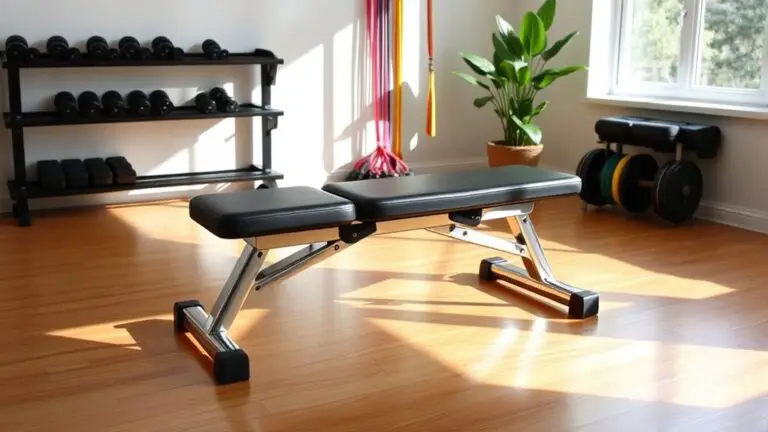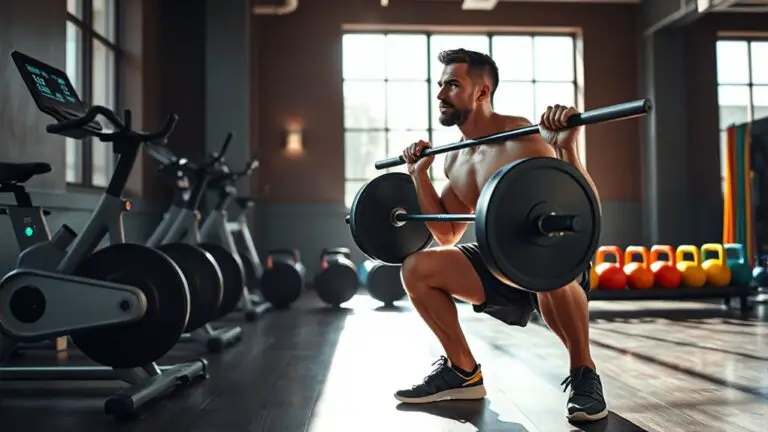Free Weights vs. Machines: Which Is Better for Muscle Growth?
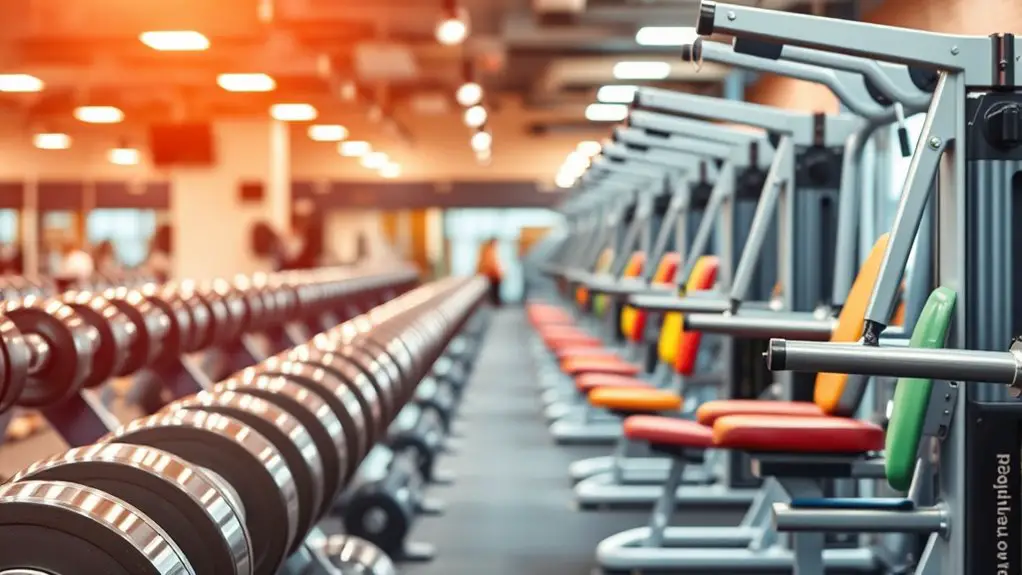
When it comes to muscle growth, both free weights and machines have their merits. Free weights engage stabilizing muscles and promote functional strength, while machines offer controlled movements that reduce injury risk. Free weights allow for a greater range of motion and core activation, but they can be more challenging for beginners. Ultimately, combining both approaches may maximize results for your specific training goals. You’ll soon discover more insights on how to tailor your routine effectively.
Understanding Muscle Growth

Muscle growth, or hypertrophy, hinges on a complex interplay of mechanical tension, metabolic stress, and muscle damage. When you lift weights, your muscles experience tension that triggers adaptive responses, leading to growth. This mechanical tension is essential, as it not only stimulates muscle fibers but also activates satellite cells, which play an important role in muscle repair and growth.
Moreover, metabolic stress from high-rep training can induce hormonal responses that promote muscle hypertrophy. However, it’s necessary to balance this with adequate muscle recovery. Recovery allows your body to repair the micro-tears caused by intense workouts, leading to stronger and larger muscles over time. Neglecting recovery can hinder your progress, as overtraining may result in fatigue and injury. As a result, understanding the dynamics of mechanical tension, metabolic stress, and the importance of muscle recovery is fundamental for optimizing your muscle growth strategy.
Benefits of Free Weights
When it comes to building strength and size, free weights offer unique advantages that can greatly enhance your training regimen. By incorporating free weights into your workouts, you can experience improved muscle engagement and develop functional strength that translates to everyday activities. Here are some key benefits:
- Increased Muscle Activation: Free weights require your stabilizing muscles to engage, leading to a more thorough workout.
- Better Range of Motion: They allow for natural movements, promoting flexibility and joint health.
- Enhanced Core Stability: Lifting free weights challenges your core, improving balance and stability.
- Versatility: You can perform a wide variety of exercises targeting multiple muscle groups, making your workouts more dynamic.
Drawbacks of Free Weights
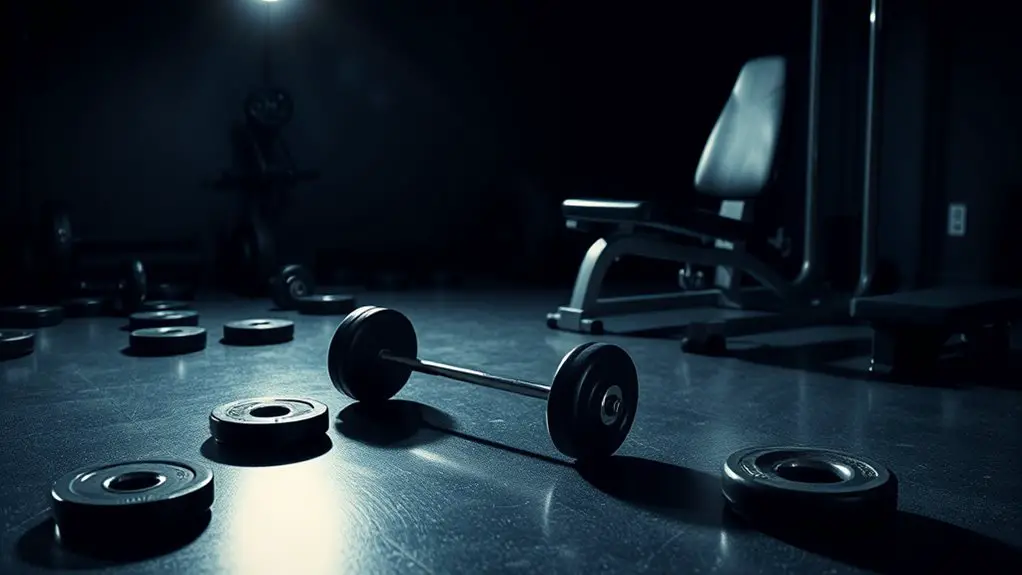
Although free weights offer numerous benefits, they also come with several drawbacks that can impact your training experience. One significant issue is the stability required when using free weights, which can lead to safety concerns, particularly for beginners. Without proper form or balance, you risk injury, making it vital to focus on technique. Additionally, there’s a notable learning curve involved. If you’re new to resistance training, mastering the correct movements can be challenging and may require more time compared to machine-based workouts. This learning curve can sometimes be discouraging, especially when immediate results aren’t visible. Furthermore, the necessity for increased focus and coordination can lead to quicker fatigue, reducing your overall workout efficiency. While many enthusiasts advocate for free weights, it’s important to recognize these drawbacks to guarantee a safe and effective training regimen. Balancing your approach with these considerations in mind can optimize your muscle growth journey.
Advantages of Machines
Free weights may pose challenges, but machines offer a different set of advantages that can enhance your training experience. Here are some key benefits you should consider:
- Machine Versatility: Machines can target multiple muscle groups, allowing you to switch between exercises seamlessly.
- Isolation Exercises: They excel at isolating specific muscles, making it easier for you to focus on areas that need improvement.
- User-Friendly: Machines often come with guided paths, which can help you maintain proper form and reduce the risk of injury, especially for beginners.
- Progressive Overload: Many machines allow you to incrementally increase weight, making it easier to track your progress and push your limits.
Incorporating machines into your routine can complement your free weight training, providing a balanced approach to muscle growth and overall fitness.
Disadvantages of Machines
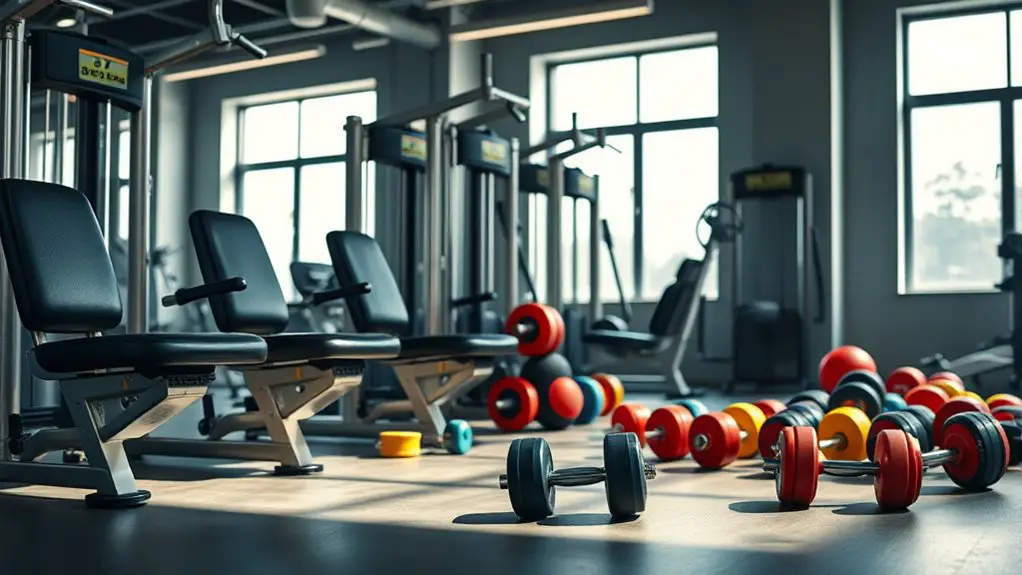
While machines provide a range of benefits, they also come with notable disadvantages that can impact your training outcomes. One major drawback is the limited range of motion they often offer. This restriction can lead to muscle isolation, focusing primarily on specific muscle groups while neglecting others, which might not yield balanced strength development. Additionally, machines may present uneven resistance throughout the movement, potentially causing strength imbalances and frustration.
Another concern is the dependency issues that arise with machine use; relying heavily on them can inhibit your ability to engage stabilizing muscles, which are vital for overall strength and functional fitness. This reduced engagement can diminish the effectiveness of your workouts and slow down muscle growth. Ultimately, while machines can be useful, it is important to be aware of these limitations and consider incorporating free weights for a more thorough training approach.
The Role of Stabilizing Muscles
Incorporating free weights into your training can greatly enhance the engagement of stabilizing muscles, which play an essential role in overall strength and functional fitness. Unlike machines that often isolate muscle groups, free weights require your body to recruit stabilizing muscles for balance and control. This stabilizing muscle engagement has significant core strength implications, leading to better performance in daily activities and sports.
Incorporating free weights boosts stabilizing muscle engagement, enhancing strength and functional fitness for daily activities and sports.
Here are four key benefits of focusing on stabilizing muscles:
- Improved Coordination: Engaging stabilizers enhances your body’s ability to coordinate movement patterns.
- Increased Overall Strength: Strengthening stabilizing muscles contributes to better performance in compound lifts.
- Reduced Injury Risk: A strong core and stabilizers can help protect against injuries during physical activities.
- Enhanced Functional Fitness: Improved stability translates to better performance in real-life movements.
Safety Considerations
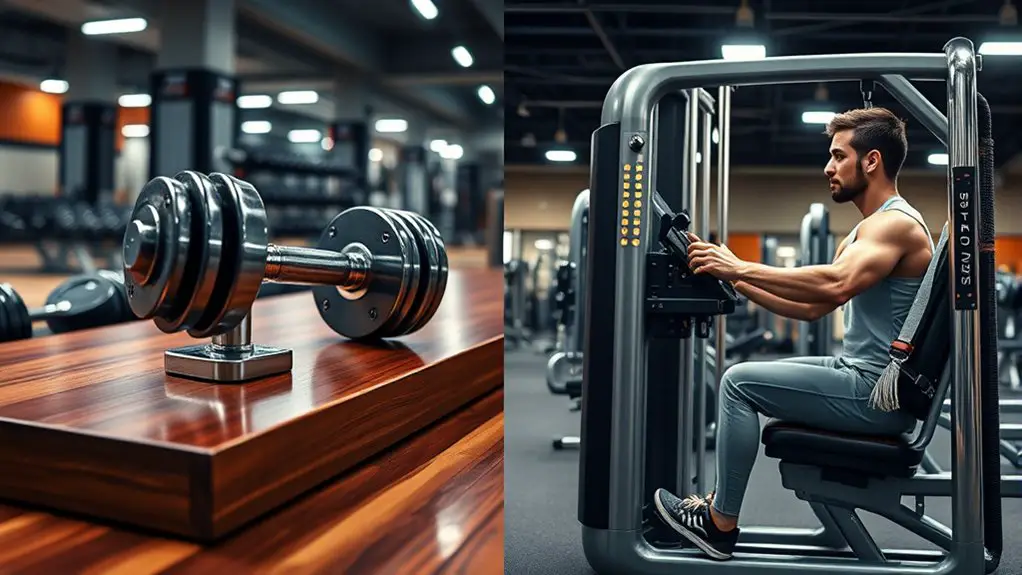
When you’re choosing between free weights and machines, safety is a key factor to evaluate. Free weights require greater control and stability, which can increase the risk of injury if not used properly. On the other hand, machines often provide guided movements that can reduce injury risk but may also limit muscle engagement.
Equipment Stability and Control
Although both free weights and machines can effectively build muscle, the stability and control each offers greatly impact safety during workouts. Here’s how they compare regarding equipment stability and control:
- Free Weights: Require greater stability training, demanding you engage stabilizer muscles and use control techniques to maintain proper form.
- Machines: Provide fixed paths of movement, offering more stability and reducing the need for extensive control techniques.
- Balance: Free weights improve balance and coordination, while machines may limit functional movement patterns.
- Adaptability: Free weights can be adjusted to different body types, but machines often come with predefined settings that might not fit everyone.
Considering these factors can help you choose the right equipment for a safe and effective workout.
Injury Risk Factors
Choosing the right equipment not only influences your muscle growth but also plays a significant role in injury risk. Free weights, while effective for building strength, can lead to injury types like strains or sprains if your form isn’t spot on. Machines, on the other hand, often provide more stability, which can reduce the likelihood of these injuries. However, they may also encourage poor movement patterns if relied upon too heavily. It’s vital to incorporate proper rehabilitation techniques if injuries do occur, allowing you to recover safely and effectively. Ultimately, understanding these risks can help you make informed choices about your training regimen, ensuring you balance muscle growth with safety.
Training for Different Experience Levels
When you’re starting out, mastering form is essential to avoid injury and build a strong foundation. As you progress to an intermediate level, balancing your techniques will help enhance muscle engagement and prevent plateaus. Finally, advanced lifters should focus on progressive overload strategies to continuously challenge their muscles and stimulate growth.
Beginners: Focus on Form
As you commence your fitness journey, prioritizing proper form is essential for preventing injuries and maximizing muscle growth. Focusing on technique helps you establish a solid foundation. Here are key aspects to take into account:
- Proper Stance: Verify your feet are shoulder-width apart for stability during lifts.
- Grip Variations: Experiment with different grips (overhand, underhand) to target various muscle groups effectively.
- Controlled Movements: Avoid rushing; controlled motions enhance muscular engagement and reduce injury risk.
- Mind-Muscle Connection: Concentrate on the muscles being worked to improve activation and overall performance.
Intermediate: Balance Techniques
Building on the foundation of proper form is essential as you progress to an intermediate level in your training. At this stage, incorporating balance training and stability exercises can greatly enhance your performance. These techniques not only improve your core strength but also stabilize your joints, reducing the risk of injury. Exercises like single-leg deadlifts or stability ball push-ups challenge your balance, forcing your muscles to engage more fully. Research indicates that integrating balance training can lead to greater overall muscle activation and functional strength, which is crucial as you aim for muscle growth. By focusing on these aspects, you’ll optimize your workouts, ensuring that your body adapts effectively to increased demands while maintaining proper alignment and control.
Advanced: Progressive Overload Strategies
To effectively stimulate muscle growth, understanding and applying progressive overload strategies is essential, especially as you advance in your training. As you become more experienced, you’ll need to employ specific overload techniques to continually challenge your muscles. Here are four effective strategies:
- Increase Weight: Gradually add weight to your lifts to enhance progressive resistance.
- Increase Reps: Aim for more repetitions at the same weight to push your limits.
- Change Tempo: Manipulate the speed of your lifts, focusing on slower eccentric movements for added tension.
- Decrease Rest Time: Shorten your rest intervals to increase intensity and endurance.
Combining Free Weights and Machines
While many lifters often debate the merits of free weights versus machines, combining both can yield significant benefits for muscle growth and overall strength. This hybrid training approach not only enhances workout variety but also allows you to target muscles more effectively. By incorporating both methods, you can leverage the stability of machines and the functional strength gained from free weights.
| Free Weights | Machines |
|---|---|
| Engage stabilizer muscles | Provide controlled movement |
| Allow for functional movements | Reduce injury risk |
| Foster muscle coordination | Target specific muscle groups |
Using free weights helps improve your balance and coordination, while machines can assist in isolating muscles without the need for stabilizers. Adopting a mixed routine can maximize your results, ensuring a well-rounded fitness regimen that promotes muscle growth and strength development.
Making the Right Choice for Your Goals

When choosing between free weights and machines, it’s essential to align your decision with your personal fitness objectives. Your experience level and any existing injuries also play significant roles in determining which option is safer and more effective for you. By considering these factors, you can optimize your training and make informed choices that best suit your goals.
Personal Fitness Objectives
Understanding your personal fitness objectives is essential for selecting the right training approach, as different goals often require tailored strategies. Your fitness goals and workout preferences will guide your choice between free weights and machines. Consider the following:
- Muscle Building: Free weights typically promote greater muscle activation and growth.
- Rehabilitation: Machines offer controlled movements, which can be safer for injury recovery.
- Convenience: Machines may suit those with limited space or who prefer a structured environment.
- Variety: Free weights allow for more diverse exercises, enhancing overall coordination and balance.
Experience and Skill Level
Your experience and skill level play an essential role in determining whether free weights or machines are the better option for your training regimen. If you’re a beginner, machines might be more suitable, as they provide guidance and reduce the risk of improper form. This can build confidence in your abilities. However, if you’ve got experience and are comfortable with weightlifting, free weights can offer greater versatility and challenge, leading to more significant muscle growth.
Consider your personal preferences too; if you enjoy the dynamic nature of free weights, you’re more likely to stick with your routine. Additionally, your training environment matters. A well-equipped gym with both options allows you to switch according to your evolving skill level and goals.
Injury Prevention Considerations
While both free weights and machines have their merits, considering injury prevention is essential for making the right choice aligned with your goals. Here are four key factors to keep in mind:
- Stability: Machines offer more stability, reducing the risk of injury, especially for beginners.
- Range of Motion: Free weights require proper form, promoting natural movement patterns that can enhance rehabilitation techniques.
- Muscle Activation: Free weights engage more stabilizer muscles, potentially leading to greater functional strength but also a higher injury risk if form isn’t monitored.
- Personalization: Machines can be adjusted for specific needs, making them ideal for those focusing on injury prevention or recovering from past injuries.
Choose wisely to guarantee your workout aligns with your safety and fitness objectives.
Frequently Asked Questions
Can Beginners Use Free Weights Safely?
Absolutely, beginners can use free weights safely, but it’s essential to prioritize proper form over heavier weights. Start with lighter weights to master the movements, which helps prevent injuries. Focus on exercises that target major muscle groups and gradually increase weight selection as your confidence and strength grow. Consider seeking guidance from a knowledgeable trainer to guarantee you’re using the correct techniques, maximizing your safety and effectiveness while building strength.
How Do I Prevent Injuries With Machines?
To prevent injuries with machines, you need to focus on proper form and make necessary machine adjustments. Always guarantee the seat height and back support fit your body correctly, as improper setup can lead to strain. Start with lighter weights to master the movements, and never rush through your repetitions. Listening to your body is essential; if something feels off, stop and reassess your technique or settings to avoid injury.
Are There Specific Muscle Groups Better Suited for Machines?
When considering whether specific muscle groups are better suited for machines, isolation exercises come to mind. Machines can effectively target smaller muscle groups, like biceps or triceps, allowing for controlled movements. This is particularly beneficial for stability training, as they provide support and minimize the risk of injury. However, for compound movements involving larger muscle groups, free weights may offer more functional strength benefits. Ultimately, a balanced approach combining both is often best for overall muscle growth.
Can I Build Strength With Only Machines?
Imagine stepping into a gym filled with sleek machines, each one beckoning you to build strength. Yes, you can absolutely build strength using only machines. They offer several benefits, like guided movement and targeted muscle engagement, making strength training efficient for beginners and seasoned lifters alike. Research shows that machine-based workouts can effectively increase muscle mass and strength when combined with proper nutrition and progressive overload, so don’t underestimate their power!
What Is the Cost Difference Between Free Weights and Machines?
When considering the cost comparison between free weights and machines, you’ll find free weights often have a lower initial investment. However, machines can provide durability and equipment longevity, potentially saving you money in the long run. While free weights might require more space and maintenance, machines usually offer a more structured workout environment. Ultimately, your choice should reflect your budget, available space, and long-term fitness goals.




